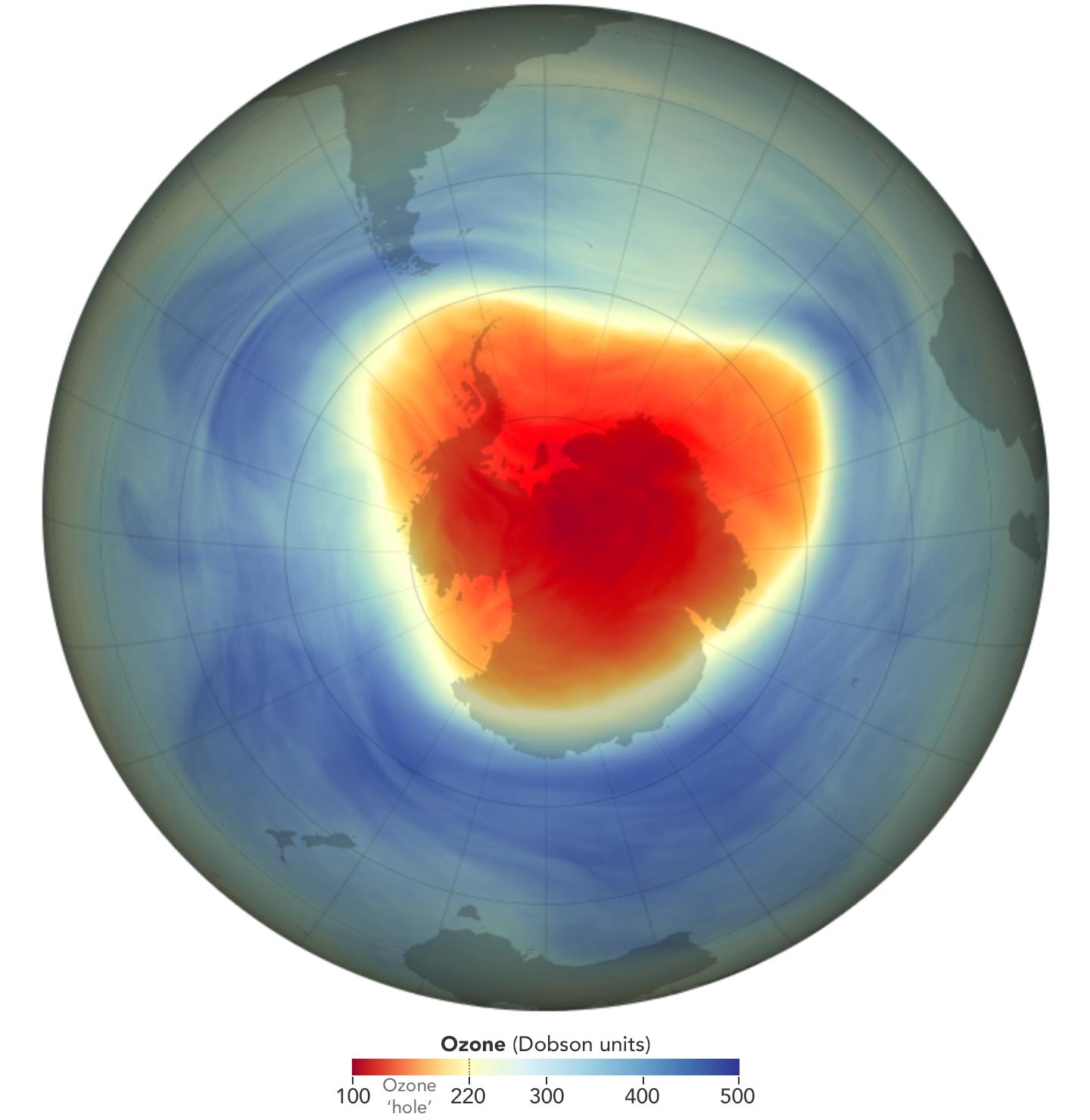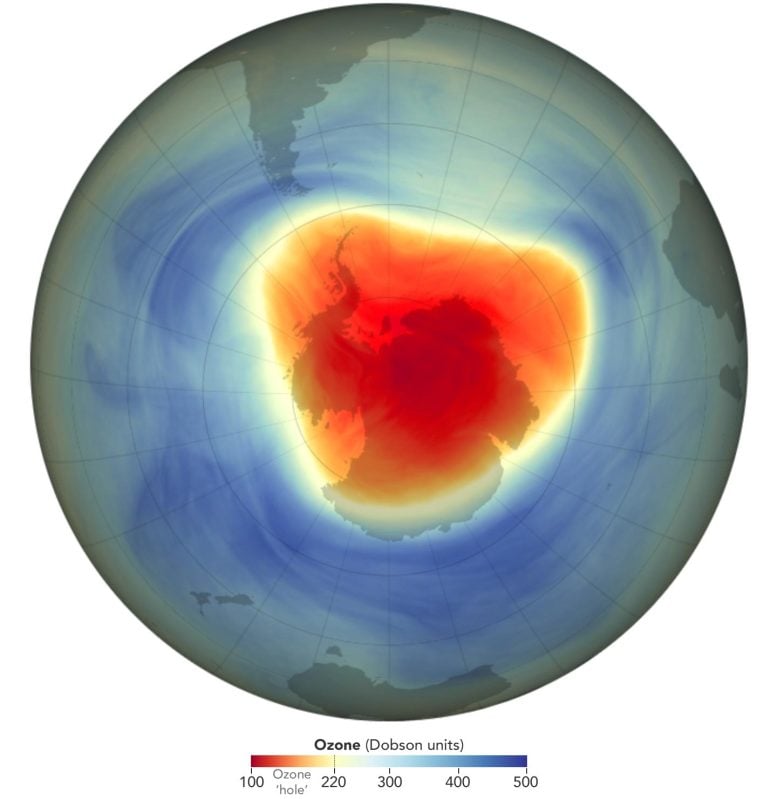

In 2024, the ozone hole over the Antarctic showed a notable reduction in size, ranking as the seventh smallest since monitoring began post-Montreal Protocol.
This improvement is credited to ongoing reductions in CFC emissions and enhanced atmospheric dynamics that transport ozone southward.
Ozone Layer Recovery Progress in 2024
In 2024, the annual hole in the ozone layer over Earth’s southern pole was relatively small compared to previous years. NASA and the National Oceanic and Atmospheric Administration (NOAA) estimate that, if current trends continue, the ozone layer could fully recover by 2066.
This year’s peak ozone depletion season, which lasts from September 7 to October 13, saw the ozone hole rank as the seventh smallest since recovery efforts began in 1992, following the Montreal Protocol—a global agreement to phase out ozone-depleting chemicals.
The ozone-depleted region over Antarctica averaged nearly 20 million square kilometers (8 million square miles) this year, covering an area almost three times the size of the contiguous United States. On September 28, the hole reached its largest single-day extent of 22.4 million square kilometers (8.5 million square miles).
The map above shows the size and shape of the ozone hole over the South Pole on the day of its 2024 maximum extent. Moderate ozone losses (orange) are visible amid areas of more potent ozone losses (red). Scientists describe the ozone “hole” as the area in which ozone concentrations drop below the historical threshold of 220 Dobson units.
What Is a Dobson Unit?
The Dobson Unit (DU) is the standard measurement for ozone concentration in Earth’s atmosphere. It quantifies the total amount of ozone in a column of air from the surface to the edge of space. One Dobson Unit equals a 0.01-millimeter layer of pure ozone at standard temperature and pressure. For example, 300 DU would form a 3-millimeter ozone layer if compressed. Scientists use Dobson Units to observe ozone health globally, providing insight into seasonal thinning and recovery patterns.
Impact of Global Efforts on Ozone Health
The improvement is due to a combination of continuing declines in harmful chlorofluorocarbon (CFC) chemicals, along with an unexpected infusion of ozone carried by air currents from north of the Antarctic, scientists said.
In previous years, NASA and NOAA have reported the ozone hole ranking using a time frame dating back to 1979, when scientists began tracking Antarctic ozone levels with satellite data. Using that longer record, this year’s hole ranked 20th smallest in area across the 45 years of observations.
“The 2024 Antarctic hole is smaller than ozone holes seen in the early 2000s,” said Paul Newman, leader of NASA’s ozone research team and chief scientist for Earth sciences at NASA’s Goddard Space Flight Center. “The gradual improvement we’ve seen in the past two decades shows that international efforts that curbed ozone-destroying chemicals are working.”
This year, the ozone hole over Antarctica reached its annual maximum extent on September 28th, 2024, with an area of 8.5 million square miles (22.4 square million kilometers.) The hole, which is actually a region of depleted ozone, was the 20th smallest since scientists began recording the ozone hole in 1979. The average size of the ozone hole between September and October this year was the 7th-smallest since the Montreal Protocol began to take effect. Credit: NASA’s Goddard Space Flight Center
UV Radiation and Ozone Depletion Concerns
The ozone-rich layer high in the atmosphere acts as a planetary sunscreen that helps shield us from harmful ultraviolet (UV) radiation from the Sun. Areas with depleted ozone allow more UV radiation to reach Earth’s surface, resulting in increased cases of skin cancer and cataracts. Excessive exposure to UV light can also reduce agricultural yields as well as damage aquatic plants and animals in vital ecosystems.
Scientists were alarmed in the 1970s at the prospect that CFCs could eat away at atmospheric ozone. By the mid-1980s, the ozone layer had been depleted so much that a broad swath of the Antarctic stratosphere was essentially devoid of ozone by early October each year. Sources of damaging CFCs included coolants in refrigerators and air conditioners, as well as aerosols in hairspray, antiperspirant, and spray paint. Harmful chemicals were also released in the manufacture of insulating foams and as components of industrial fire suppression systems.
Monitoring and Future Outlook
The Montreal Protocol was signed in 1987 to phase out CFC-based products and processes. Countries worldwide agreed to replace the chemicals with more environmentally friendly alternatives by 2010. The release of CFC compounds has dramatically decreased following the Montreal Protocol. But CFCs already in the air will take many decades to break down. As existing CFC levels gradually decline, ozone in the upper atmosphere will rebound globally, and ozone holes will shrink.
“For 2024, we can see that the ozone hole’s severity is below average compared to other years in the past three decades, but the ozone layer is still far from being fully healed,” said Stephen Montzka, senior scientist of the NOAA Global Monitoring Laboratory.
Researchers rely on a combination of systems to monitor the ozone layer. They include instruments on NASA’s Aura satellite, the NOAA-20 and NOAA-21 satellites, and the Suomi NPP satellite, jointly operated by NASA and NOAA.
NOAA scientists also release instrumented weather balloons from the South Pole Baseline Atmospheric Observatory to observe ozone concentrations directly overhead. The 2024 concentration reached its lowest value of 109 Dobson units on October 5. The lowest value ever recorded over the South Pole was 92 Dobson units in October 2006.
NASA and NOAA satellite observations of ozone concentrations cover the entire ozone hole, which can produce a slightly smaller value for the lowest Dobson unit measurement.
“That is well below the 225 Dobson units that was typical of the ozone cover above the Antarctic in 1979,” said NOAA research chemist Bryan Johnson. “So, there’s still a long way to go before atmospheric ozone is back to the levels before the advent of widespread CFC pollution.”
View the latest status of the ozone layer over the Antarctic with NASA’s Ozone Watch.
NASA Earth Observatory image by Lauren Dauphin, using data courtesy of NASA Ozone Watch and GEOS-5 data from the Global Modeling and Assimilation Office at NASA GSFC.